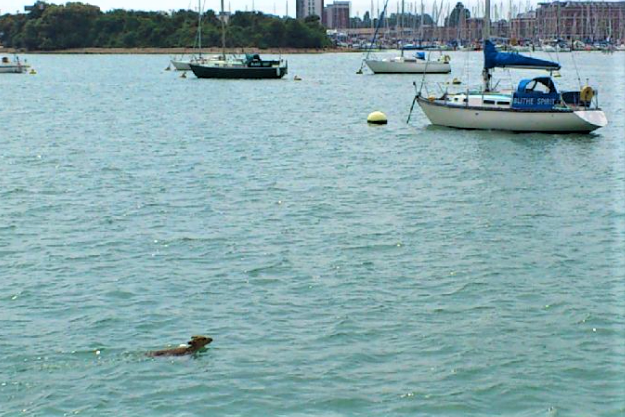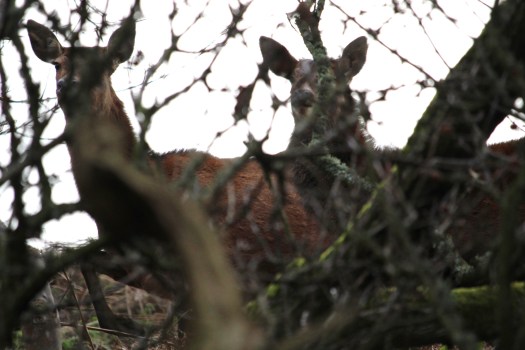
A red deer hiding in some bracken on the Isle of Wight
Isle of Wight Deer-A few myths
The history of wild deer on the Isle of Wight reflects the neighbouring areas on the mainland coasts of Hampshire & Dorset,with deer populations establishing after the last Ice Age and fluctuating ever since.
Both wild and captive deer probably disappeared altogether from the island in the middle of the 19th century, around the time that the Worsley Estate was sold and carted deer hunting ceased, and only began to be seen again in the wild in the early1970s
Wild deer remain comparatively scarce on the Isle of Wight, Red and Muntjac are probably the most common species with the odd Fallow and Roe or Sika occasionally being seen. Deer are sometimes seen swimming across Southampton Water and the Solent to and from the island.
A few myths about our resident wild Isle of Wight deer:-
1. There are no wild deer on the Isle of Wight
Many people will have heard that the Isle of Wight has a “deer free status”, the Forestry Commission have recently clarified what they mean by this:- ” This is of course a relative term which compares the minimal deer numbers on the Isle of Wight with significant populations on the mainland”. Obviously their use of the term “deer free” has been very misleading.

Both red & roe deer similar to these are native to the island
2. Deer are an introduced species like Grey Squirrels and American Mink
There are 6 species of wild deer in the UK, evidence of 5 of which have all been seen on the island in recent years. Red and Roe are native* deer that recolonised England including the land that was to become the Isle of Wight after the last Ice Age, whilst Muntjac, Fallow and Sika are introduced species.
3. They are all deer farm escapes and there are no naturally occurring deer on the island
Red deer and Muntjac have been breeding in the wild for some years now and deer are known to swim across the Solent*. The last commercial deer farm on the island closed around the year 2000**. Roe and Muntjac are not kept in deer farms at all. A FOI request revealed that the IWC had no evidence to support their claim that there are no naturally occurring deer on the island.

A Roe doe – They are not kept on deer farms or in captivity anywhere on the Isle of Wight
No public authority has been able to produce firm evidence of any escaped farmed deer on the Isle of Wight when challenged under FOI/EIR regulations
4. The vegetation on Isle of Wight is more lush and varied compared to the mainland and biodiversity is greater due to the relative absence of deer
The mild climate and geology of the Isle of Wight are the prime reasons for our vegetation being different from many areas of the mainland and was recorded as such hundreds of years ago when wild deer were more abundant on the island. Both historical and archaeological records show that our rich woodlands evolved in the presence of wild deer.
Dorset claims greater floral diversity than the island whilst Hampshire claims to have the most varied biodiversity in the country, both of these counties have strong deer populations.

A fantastic floral display in a wood inhabited by Roe deer on the nearby mainland
5. Populations of rare mammals such as Woodland Bats, Red squirrels and Dormice are threatened by the presence of deer
The JNCC report on the status of our wild mammals makes no such claim, in fact Bats in particular benefit from deer grazing woodland pastures and rides which enables the Butterflies and Moths that they feed on to thrive. Some Bats also feed on the coprophagous insects found in deer dung.
6. Nightingales are only found when deer are absent
Nightingales breed mostly south of the Severn-Wash line and east from Dorset to Kent. The highest densities are found in the south east: Essex, Suffolk, Norfolk, Kent and Sussex, all these counties have significant populations of wild deer. In common with the mainland Nightingale numbers have declined sharply on the island since the second half of the 20th century.

BTO Nightingale Distribution Survey
7.Woodland Biodiversity is harmed by deer
It has been established by scientific research conducted in North America, Great Britain and Europe that woodland biodiversity is at its greatest when deer are present at low density and decreases when deer are either totally absent or at a very high density.
8. In the UK deer spread diseases such as bluetongue
Bluetongue is a non-contagious disease of ruminants found in tropical and subtropical areas that rarely occurs elsewhere, it is carried and spread by the Culicoides imicola midge that cannot overwinter in our climate. No deer within the UK have ever been found to be infected with this virus.
9. Pregnant deer are more damaging to the environment than non-breeding deer
Whether a deer population has positive or negative environmental impacts is primarily down to deer density, i.e. optimum numbers with neither too few or too many (see What happens when you have too few deer?). Apart from a relatively minor positive contribution from the products of parturition to both vertebrate and invertebrate scavengers there appears to be no environmental significance to whether a deer population is breeding or not.

10. Deer cause Lyme Disease
Lyme disease is an infection caused by a group of bacteria called Borrelia burgdorferi which are transmitted to humans following a bite from an infected Sheep tick Ixodes ricinus. Despite its name the Sheep tick will feed from a wide variety of mammals and birds. Bites from other ticks are possible, including the Hedgehog tick , Ixodes hexagonus, and the Fox and Badger tick, Ixodes canisuga. These ticks become infected during their larval and nymphal phases by feeding on the small mammals and birds which harbour the Lyme bacterium. Later in their development the infected nymphs and adults transfer the Lyme bacteria to the animals and people on which they feed. On the Isle of Wight there are over 30,000 Sheep and abundant small mammals and wild birds that can perform the role of a host for the Ixodid ticks and the diseases that they carry. Deer are described as “incompetent hosts” for these Lyme disease causing bacteria and do not transmit the infection back to the ticks.
The important thing is to be aware of the dangers caused by a tick bite and to seek prompt medical help if bitten. Take special care when walking through long damp grass etc. as this is where ticks are found after falling off one host to await the next. More useful information may be found on the Lyme Disease Action Website and in “Science Daily – Lyme Disease: You can’t blame the deer”
*Native species (indigenous)A species, subspecies or lower taxon, occurring within its natural range (past and present) and dispersal potential (i.e. within the range it occupies naturally or could occupy without direct or indirect introduction or care by humans)IUCN 2000
** In August 2019 Newclose Farm opened an entirely new deer farming enterprise to the public
If you have seen some deer on the island please take part in the Isle of Wight Deer Survey locations will be treated with strictest confidence. For periodic updates please visit Isle of Wight Deer Conservation or email deerwight@gmail.com
British Deer Society Position Statement – Isle of Wight Deer
For greater details about wild deer within the UK please visit the British Deer Society website – BDS
Thank you for your interest and support, you may also find FAQs about the island’s deer interesting.
For more photos of deer on the Isle of Wight please see the Isle of Wight Deer Album

Wild Red deer yearling Isle of Wight




































